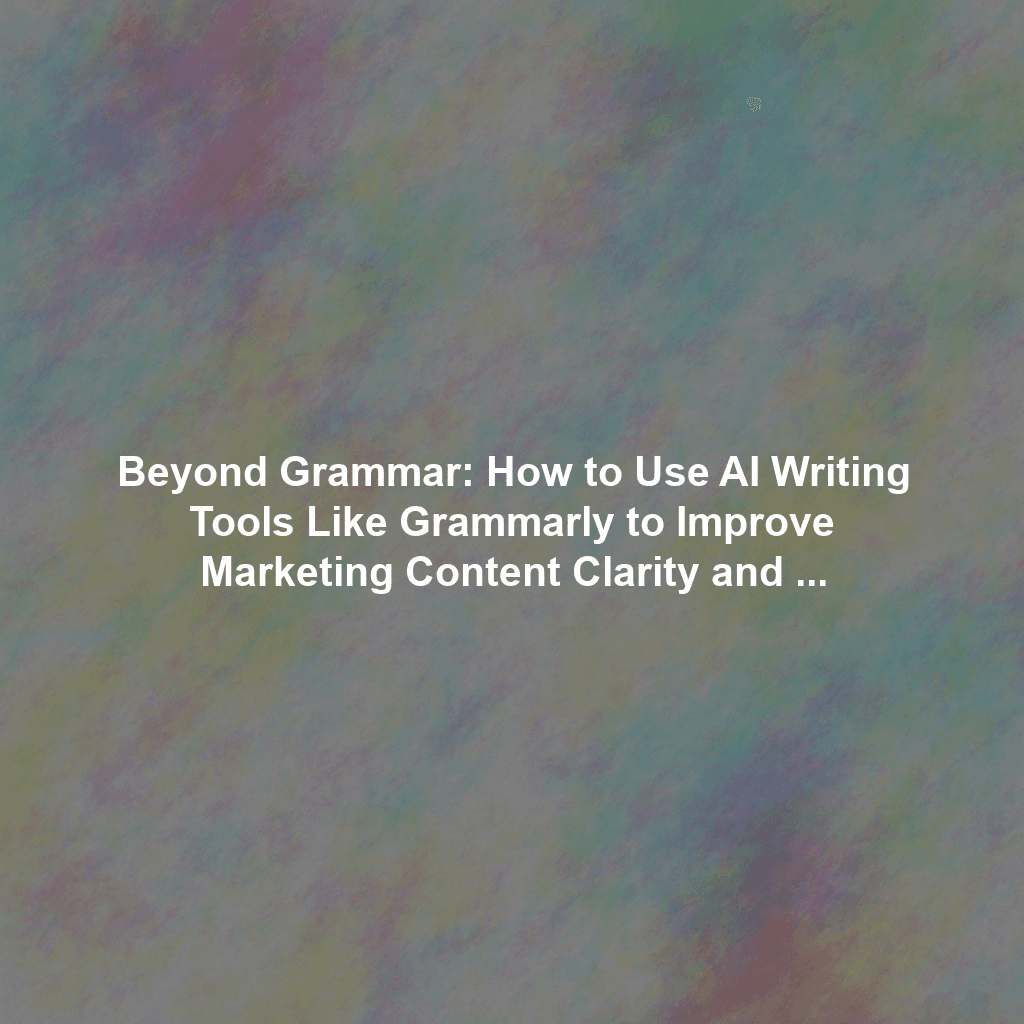In today’s competitive digital landscape, crafting compelling marketing content is paramount. While flawless grammar is a given, it’s no longer enough. Marketers need to captivate audiences, convey their message with crystal clarity, and ultimately, drive conversions. Enter AI-powered writing assistants like Grammarly, which have evolved far beyond simple grammar checkers to become powerful tools for optimizing marketing content for maximum impact.
The Evolution of AI Writing Assistants in Marketing
Initially, writing tools primarily focused on identifying grammatical errors and spelling mistakes. However, advancements in artificial intelligence and natural language processing (NLP) have transformed these tools into sophisticated content optimization platforms. Today, these platforms analyze text for clarity, tone, engagement, and even potential persuasiveness, offering real-time suggestions to enhance the overall effectiveness of marketing materials.
More Than Just Correcting Mistakes: Understanding Context and Tone
Modern AI writing assistants understand the context of your writing. They don’t just flag a passive voice construction; they analyze if that passive voice is appropriate for the situation or if an active voice would be more impactful. They also assess the overall tone of your content and provide suggestions to ensure it aligns with your brand voice and the intended audience. Are you aiming for a formal, authoritative tone, or a more friendly and approachable one? AI can help you achieve consistency.
Boosting Conversion Rates with AI-Powered Content Optimization
The true value of AI writing tools in marketing lies in their ability to improve conversion rates. By refining your content for clarity, persuasiveness, and engagement, you can significantly increase the likelihood of readers taking desired actions, such as making a purchase, subscribing to a newsletter, or requesting a demo.
Optimizing Landing Page Copy for Maximum Impact
Your landing page is often the first impression a potential customer has of your brand. It needs to be clear, concise, and compelling. AI writing tools can help you:
- Simplify complex language: Ensure your message is easily understood by your target audience, regardless of their background or expertise.
- Strengthen your value proposition: Highlight the benefits of your product or service in a way that resonates with potential customers.
- Optimize your call-to-action (CTA): Craft CTAs that are clear, actionable, and persuasive, encouraging visitors to take the next step.
- Identify and eliminate jargon: Remove industry-specific terms that may confuse or alienate your audience.
For example, instead of saying “Leverage our synergistic platform to optimize your workflow,” an AI tool might suggest “Use our easy-to-use platform to streamline your work.”
Crafting Email Subject Lines That Get Opened
In the crowded inbox, your email subject line is your first and only chance to grab attention. AI writing assistants can help you create subject lines that are:
- Intriguing and relevant: Capture the reader’s interest and clearly communicate the value of the email.
- Concise and to the point: Keep your subject line short and sweet, avoiding unnecessary words or phrases.
- Action-oriented: Use verbs that encourage the reader to open the email.
- Personalized (where appropriate): Tailor the subject line to the individual recipient to increase engagement.
For instance, an AI tool might suggest changing “Important Update Regarding Your Account” to “Action Required: Update Your Account Information for Enhanced Security.”
Improving Clarity in Blog Posts and Articles
Content marketing relies heavily on providing valuable and easily digestible information. AI writing tools can ensure your blog posts and articles are:
- Well-structured and organized: Improve readability with clear headings, subheadings, and bullet points.
- Free of grammatical errors and typos: Maintain a professional image and build trust with your audience.
- Written in a clear and concise style: Avoid jargon, complex sentence structures, and ambiguous language.
- Optimized for search engines (SEO): Identify opportunities to incorporate relevant keywords and improve your content’s visibility in search results.
Choosing the Right AI Writing Assistant for Your Needs
Several AI writing tools are available, each with its own strengths and weaknesses. Consider your specific needs and budget when making a decision. Some popular options include:
- Grammarly: A comprehensive writing assistant that offers a wide range of features, including grammar and spell checking, style suggestions, and plagiarism detection.
- ProWritingAid: A powerful tool that provides in-depth analysis of your writing, identifying areas for improvement in grammar, style, and readability.
- Hemingway Editor: A free tool that helps you simplify your writing by highlighting complex sentences and adverbs.
Conclusion: Embracing AI to Enhance Your Marketing Content
AI writing tools are no longer a luxury; they’re a necessity for marketers who want to create high-quality, engaging content that drives conversions. By leveraging the power of AI, you can optimize your marketing materials for clarity, persuasiveness, and impact, ultimately achieving better results and maximizing your return on investment. While these tools shouldn’t replace human creativity and strategic thinking, they can significantly enhance the writing process and empower marketers to create content that truly resonates with their target audience. Embrace the future of marketing and unlock the potential of AI writing assistants to elevate your content strategy.
 Skip to content
Skip to content

